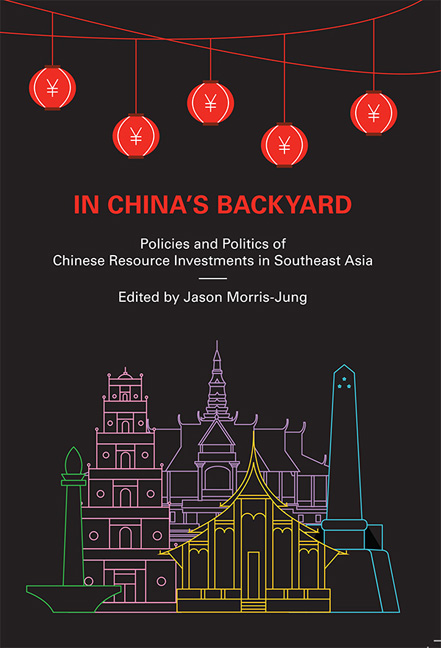Book contents
- Frontmatter
- Contents
- Foreword
- Acknowledgements
- About the Contributors
- 1 Introduction
- 2 Mixed Motivations, Mixed Blessings: Strategies and Motivations for Chinese Energy and Mineral Investments in Southeast Asia
- 3 Mineral Resources in China's “Periphery” Diplomacy
- 4 Energy Entanglement: New Directions for the China–Indonesia Coal Relationship
- 5 Indonesia–China Energy and Mineral Ties: The Rise and Fall of Resource Nationalism?
- 6 The Direction, Patterns, and Practices of Chinese Investments in Philippine Mining
- 7 Development Cooperation with Chinese Characteristics: Opium Replacement and Chinese Rubber Investments in Northern Laos
- 8 The High Cost of Effective Sovereignty: Chinese Resource Access in Cambodia
- 9 Complex Contestation of Chinese Energy and Resource Investments in Myanmar
- 10 Anti-Chinese Protest in Vietnam: Complex Conjunctures of Resource Governance, Geopolitics and State–Society Deadlock
- 11 Complexities of Chinese Involvement in Mining in the Philippines
- 12 Conclusion
- Bibliography
- Index
Foreword
Published online by Cambridge University Press: 04 July 2018
- Frontmatter
- Contents
- Foreword
- Acknowledgements
- About the Contributors
- 1 Introduction
- 2 Mixed Motivations, Mixed Blessings: Strategies and Motivations for Chinese Energy and Mineral Investments in Southeast Asia
- 3 Mineral Resources in China's “Periphery” Diplomacy
- 4 Energy Entanglement: New Directions for the China–Indonesia Coal Relationship
- 5 Indonesia–China Energy and Mineral Ties: The Rise and Fall of Resource Nationalism?
- 6 The Direction, Patterns, and Practices of Chinese Investments in Philippine Mining
- 7 Development Cooperation with Chinese Characteristics: Opium Replacement and Chinese Rubber Investments in Northern Laos
- 8 The High Cost of Effective Sovereignty: Chinese Resource Access in Cambodia
- 9 Complex Contestation of Chinese Energy and Resource Investments in Myanmar
- 10 Anti-Chinese Protest in Vietnam: Complex Conjunctures of Resource Governance, Geopolitics and State–Society Deadlock
- 11 Complexities of Chinese Involvement in Mining in the Philippines
- 12 Conclusion
- Bibliography
- Index
Summary
Over the last three decades, one of the most significant changes in the context of development in the Global South is the transformation of China from a capital deficient developing country to a rising capital exporter in the world economy. For a long time, the main form of China's capital export is its massive purchase of US Treasury bonds. But since the Hu Jintao era (2002–12), the Chinese state has diverted ever larger part of its foreign reserves to outgoing direct investment in infrastructures, mines, and other assets in the developing world. China's official financial institutions also started offering concession loans to other developing countries.
Africa has been the most prominent recipient of Chinese investment, partly because of the PRC's longstanding presence in the continent since the height of Cold War and partly because of Africa's abundance in fossil fuel and mineral resources that China needs desperately for its roaring developmental machine. “China in Africa” has been an established field in development studies. Numerous papers and books debated whether China's increasing presence in Africa would elevate the region's growth prospect or whether it represents little more than a new form of extractive colonialism.
China's ambitions in becoming a major capital exporter to the developing world is surely not restricted to Africa. Chinese investments in Latin America, the Middle East, and Southeast Asia has been increasing rapidly. Among all these regions, Southeast Asia, which is right at the doorstep of China, is the most interesting one, and it is poised to becoming the most important arena for China's overseas projection of political-economic influences.
China's presence in Southeast Asia dates back to premodern times, when many states in the region paid tribute to the dynastic state ofimperial China and conducted trade with China via Chinese diasporic traders in the region. Time and again, some states in the region attempted to challenge Chinese dominance and sever its tributary ties to China. But at least in the perception of many officials and intellectuals in China, these challenges did not alter the reality that China had been hegemonic over Southeast Asia all along until Western imperialism shattered this Sinocentric other in the mid-nineteenth century. China's link to the region receded in the mid-twentieth century because of Cold War division, only to be restored after China's reintegration into the capitalist world in the 1980s.
- Type
- Chapter
- Information
- In China's BackyardPolicies and Politics of Chinese Resource Investments in Southeast Asia, pp. vii - viiiPublisher: ISEAS–Yusof Ishak InstitutePrint publication year: 2017

